In 1988, I wrote a 4-issue PEACEMAKER miniseries (based on the original Charlton Comics character, created, written, and drawn by the late, great Pat Boyette), which featured art by Tod Smith and Pablo Marcos, but another deep dive into the files reveals the following proposal for an ongoing PEACEMAKER series that I pitched, apparently after the cancellation of CHECKMATE #33 (January 1991), where the character had been appearing since his reintroduction in VIGILANTE a few years earlier. The new series would have opened after disappearance of Christopher (Peacemaker) Smith and the introduction of a new man-behind-the-silly-helmet, Richard Carter. Had it been picked up, the new PEACEMAKER series would have gone something like this…

PEACEMAKER is missing in action, presumed dead. During a Checkmate! mission in the European nation of Austanburg (CHECKMATE #33), the chronically unstable Christopher Smith blew his cork but good and disappeared. The last any of the good guys saw of him was as his assault helicopter crash landed; in the heat of battle, nobody was able to confirm whether Peacemaker was aboard the downed chopper.
Smith hasn’t been heard from since, so it’s assumed that he perished in the assault. Something of a loose cannon in the espionage community for his single-minded pursuit of terrorists (and his belief that he was under the influence of his long-dead father, World War II Nazi concentration camp commandant Wolfgang Schmidt), Christopher Smith’s death wasn’t viewed as any great inconvenience to Checkmate!; he was simply more trouble than he was worth at times.
That view, however, wasn’t shared by the personnel of Pax Institute, Smith’s Geneva, Switzerland based organization dedicated to promoting peaceful alternatives to potentially violent world situations, and the study and treatment of terrorism and its victims. In addition to its legitimate pursuits, Smith used Pax as a cover for his Peacemaker activities.
With Smith presumed dead, the Institute was granted conservatorship of his vast estate to continue its work… and then someone came up with the bright idea of “creating” a new Peacemaker to take Christopher Smith’s place.
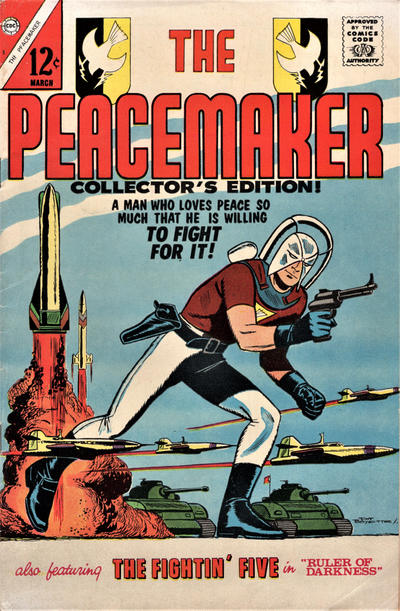
PEACEMAKER II: Nora O’Rouke (Smith’s one-time assistant, now head of Pax Institute) believed in Smith’s intent, if not in the actual execution of his work as Peacemaker. What’s needed, she reasoned, is someone with the first Peacemaker’s skills in the body of a sane and reasonable agent. And, rather than him operating as a loner, the new Peacemaker would be a public figure, a recognized agent of Pax Institute, complete — if she can swing it — with the sanction of the United Nations!
Nora O’Rouke relocates Pax from Switzerland to New York city, creating a new image for the organization by immersing it in the global politics of the day. The world is undergoing massive changes in the 1990s. In Eastern Europe, the Middle East, Western Europe… each day brings dramatic new changes to the world order, making it more important than ever to bring a reasoned, neutral party to help mediate sensitive situations. Pax Institute is able to sucessfully involve itself in several such matters, gaining credibility in the media, the public eye, and the international diplomatic scene.
While working on Pax’s public image, the equally important work of selecting a new agent to assume the role of Peacemaker went on behind the scenes. Through government contacts in the intelligence community, Nora O’Rouke had access to the personnel files of several branches of the intelligence services. She chose, from among the scores of candidates, Lt. Cmdr. (Ret.) Richard Carter, a 36-year old agent with the National Bureau of Investigation (NBI). Carter’s qualifications to fill the role are exemplary in terms of experience, psychological profile, and a commitment to the pursuit of peace.
Carter was born in Rome, Indiana, a small farming community on the Kentucky border. Carter was the second of four children, born to parents who embodied solid American values. His father owned a medium-sized family farm and he raised his children to believe there was a reason to raise the American flag in the front yard each morning, that the celebration of the Fourth of July should mean more than an excuse to shoot off fireworks, that Thanksgiving has meaning beyond big dinners and televised football games. He taught his children to do what was moral and right and to never turn a blind eye to injustice.
Carter came to believe in that as well; as much as he might have liked to have denied it all in some fit of youthful rebellion, he found it hard to find fault in a philosophy that embraced even something as cliched as “truth, justice and the American way.” Richard grew up an All-American boy in an All-American life, working on the family farm, studying hard to graduate near the top of his high school class and achieving some local fame (much to his discomfort because of a relatively shy nature) in athletics, lettering in football, track and basketball. In fact it was sports that afforded him the opportunity to attend college on a football scholarship, to Indiana’s Ball State University, where he majored in political science.
Carter hoped to enter into government service of some sort and saw a possible path to achieving that through the military. After graduation from Ball State, he enlisted in the Navy, progressing rapidly through the ranks to Lieutenant Commander in the SEALs (Sea Air Land) special forces and, finally, an assignment to Naval Intelligence, from which he was recruited for the National Bureau of Intelligence (NBI).
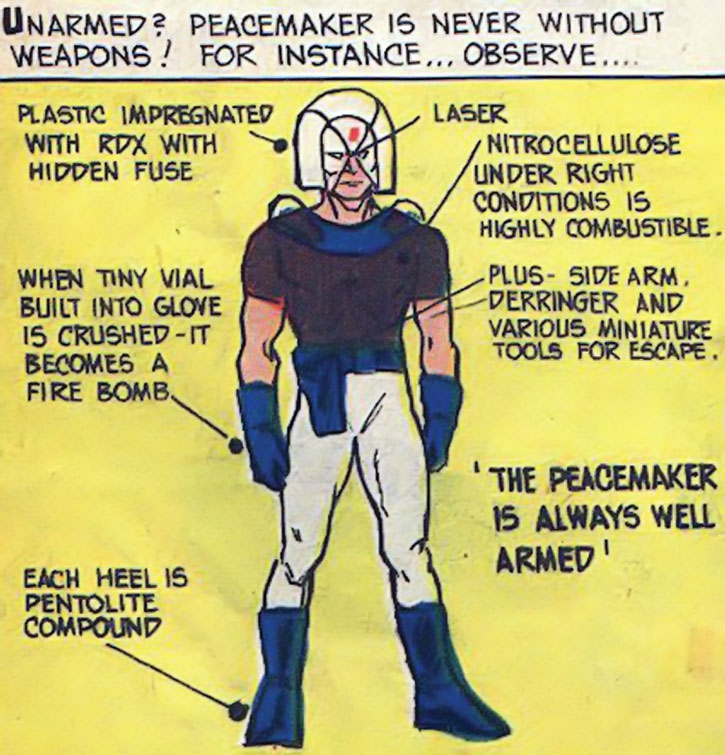
As the new Peacemaker, Carter will serve as more than just a field agent pursuing Pax’s goals. The Institute’s plans call for their new Peacemaker to be a public figure, the literal poster child for world peace and understanding. Pax will merchandise their hero, plastering his image across the media, on t-shirts and coffee mugs, with Peacemaker action figures and lunch boxes. The whole nine yards, and not exactly Carter’s cup of tea. As much as he believed in what Pax was doing, he’s used to his work being of a more secretive nature, as it was when he worked in the field for Naval Intelligence and the NBI.
PEACEMAKER: YEAR ONE
The first year of PEACEMAKER features the introduction of the new Pax Institute and the new Richard Carter Peacemaker. Carter starts off as an idealist, striving to be one of the world’s true good guys in spite of the public spotlight Pax has placed him in. He believes Pax has the best interests of the world community as its reason for existing and — as uncomfortable as the attention makes him — he’s willing to play the straight-up, square-jawed, All-American hero for the world stage.
But as the story progresses, Carter begins to detect cracks in the seeming solid facade of Pax Institute. Pax is supposed to be an independent agency, free of any influence by governments, special interests, or individuals… but that’s not the case. Carter first begins to question the missions he’s sent on: as much as he wants to keep on being the good soldier he’s always been, he’s unable — in good conscience — to do so. While the objectives seem politically correct, there’s just something about the way he’s told to go about his work that’s suspect.
The Carter Peacemaker begins to question his orders… and from questioning the orders, it’s a short leap to starting to take matters into his own hands, pursuing his own avenues of investigation and running missions the way he sees fit as opposed to the way he’s told. At the same time, his methods are getting more and more brutal as he goes along; Carter started out as an All-American hero. He’s turning into something almost as bad as his predecessor.
Pax sees this as trouble… especially since Peacemaker’s actions are beginning to spook its supporters and backers. Of course, Pax isn’t as lily-white as Carter originally believed; it’s unrealistic to believe that the organization could survive in the politically-charged realm it’s chosen without making some political/moral concessions. The moment Pax went looking for financial support from the private sector (as was necessary to finance its expansion), it was well on the road to compromise. Perhaps it’s nothing major (although that remains to be seen), but Carter doesn’t believe that Pax would have stopped with the small lie. The organization is pursuing the interests of its backers and supporters, often in opposition to the best interests of their stated goals. Pax sees this contradiction as a small price to pay for the sake of the bigger picture.
As things progress, Richard Carter grows more uncontrollable, the fabric of Pax Institute continues to unravel… and the Institute is forced to take drastic measures. Ross Llwellyn (see SUPPORTING CHARACTERS below) is dedicated to Pax’s work — one of those pragmatists willing to make the small compromise for the greater good, and, as a one-time friend and employee of Christopher Smith’s Pax Institute, he’s not willing to allow Carter to destroy what his “late” friend created. Smith may have been insane, but he managed to achieve something of importance, both with Pax Institute and as Peacemaker. Llwellyn is certain Smith would agree with him, were he still among the living.
Surprise!
He is, and Ross Llwellyn is the only person alive who knows the whole story, which goes something like this: For several years, Christopher Smith was a reluctant and tortured hero, driven by the childhood trauma of seeing his father commit suicide and the subsequent knowledge that his father had been a member of the Nazi SS, in charge of a concentrate camp where hundreds of thousands of innocents had lost their lifes. Christopher had been involved in atrocities of his own, in Viet Nam, and was convicted for his crimes. In Leavenworth, he was chosen to participate in a top secret government project to create a corps of super-soliders, trained to the peak of their abilities and supplemented by the latest in cybernetically controlled weapons. When Project: Peacemaker was discontinued due to lack of funding, Christopher fell through the cracks and was able to walk out of the Project’s training camp to freedom. He set up headquarters in Geneva, Switzerland, backed by the manufacturing fortune he’d inherited from his father.
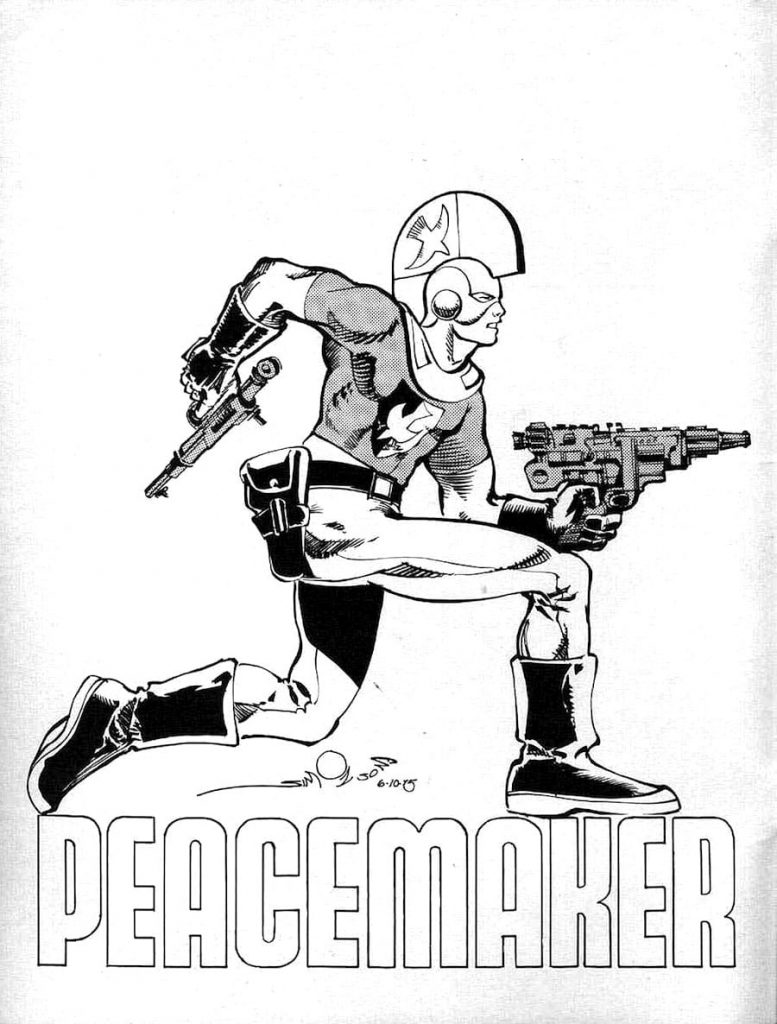
What no one could know was that the cybernetics that controlled Smith’s Peacemaker weaponry was slowly but surely driving his already damaged psyche over the brink. As a result, Smith found himself driven by the aforementioned hallucinations of his Nazi SS father to combat terrorism with singleminded brutality. Finally, during the mission in Austanburg, Smith cracked wide open and fled, unable to deal any longer with the horror show that had been running inside his head all these years. Smith had to escape, leave it all behind or be destroyed. So he discarded the Peacemaker garb and fled, with Llwellyn’s help, to South America, losing himself in the deepest, darkest rain forest he could find to begin his long, painful recovery. The cybernetics are now causing the a similar sort of violent activity in Carter, and with his actions threatening the entire Pax Institute/Peacemaker legacy, Llwellyn believes that Smith is the only man capable of taking on Carter.
Smith has effectively cut himself off from civilization in South America. He’s got a lot of past to work through, and he’s found a reason for his life out here in the middle of nowhere: helping the locals protect the rain forests from destruction. But he can’t, for personal reasons, ignore Llwellyn’s call. So he goes to help out.
The climax of the first year’s storyline has Christopher Smith taking on Peacemaker in one-on-one combat. Carter is on the verge of blowing the whistle on Pax Institute when Smith makes his reappearance, and he’s determined to see that the truth gets out on its mismanagement and compromised agenda and he believes Smith is out to protect Pax from this revelation.
In truth, Smith is testing Richard Carter. Smith wants to be sure Carter is worthy of the Peacemaker heritage… and that Carter doesn’t fall into the same trap that nearly destroyed him! He doesn’t give a whit about Pax Institute; governmental and quasi-governmental organizations such as Pax are subject to the sort of abuses Carter seeks to reveal, the same sort of institutionalized thinking that allowed Smith to continue to operate even though it was costing him his sanity. What he cares about is that a sane, rational man, a loner not hampered by regulation, be able to operate to combat the true threats to world peace and prosperity.
Smith whips Carter, but only just… and rather than deliver the expected killing stroke, Smith steps back. The fight was to see if Carter had what it took to be the new Peacemaker, that he wouldn’t disgrace the name… or Smith will be back, and next time he won’t back off! Oh, yeah, and do something about the costume’s cybernetics before they drive you totally whonky! Smith leaves Carter to his own devices — after turning over the keys to old Swiss chalet headquarters and the account number of a Swiss account to finance his work — and returns to his new rain forest home. Carter blows the whistle on Pax; Pax collapses; the cybernetics are fixed; and Carter continues operating as the new Peacemaker, under his own steam, and to hell with anybody who seeks to control his actions.
And, while he does have the cybernetics of his costume fixed, Richard Carter hasn’t been totally unaffected by the old cybernetic systems: he’s become rougher, just that much more brutal. Not anywhere near the savage the old Christopher Smith Peacemaker was… but enough to make mercy and self-restraint a difficult concept for Carter to grasp.
Enough to make the new Peacemaker an unstoppable engine of destruction against those who threaten the peace and security of the world. Enough to make Richard Carter a man who loves peace so much… he’s willing to kill for it!
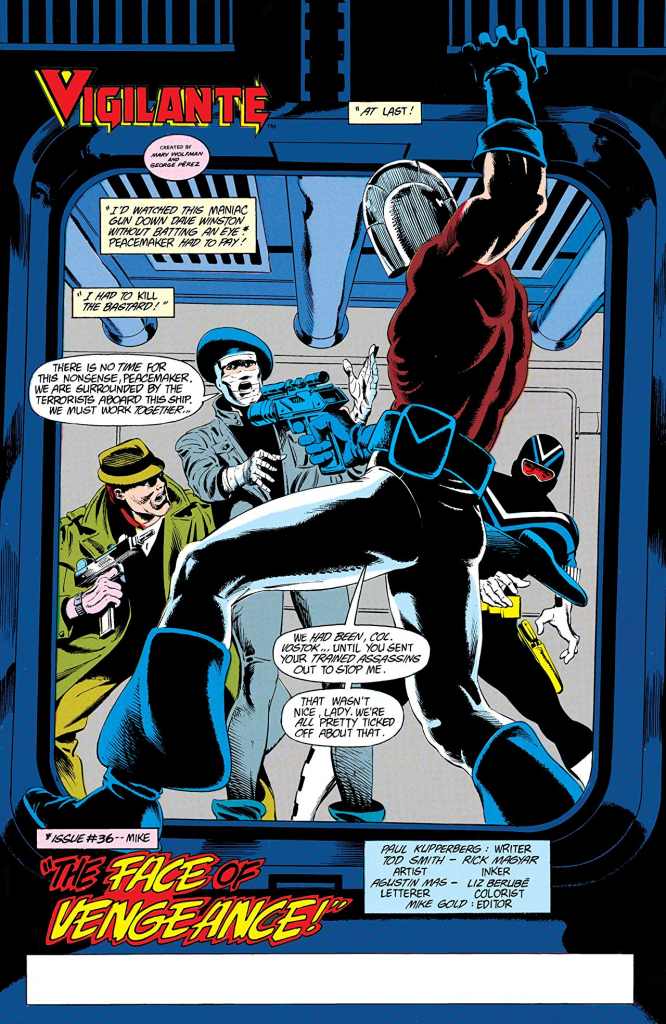
SUPPORTING CHARACTERS
• NORA O’ROUKE: A former special agent and Local Director with the FBI, Nora O’Rouke came to work as Christopher Smith’s personal assistant in running Pax Institute and took over the reigns of the organization after his death. Nora joined the Bureau directly out of law school out of a sense of duty and patriotism; graduating at the top of her class from Harvard Law School, she could have gotten rich practicing in the private sector but believed she could do far more good for the country by serving it rather than feeding off the system. As a woman in the decidedly male dominated intelligence field, she had to work harder and be better than anybody else to rise through the ranks, but she was willing and more than able, eventually being appointed as the first woman Local Director in the FBI.
• DR. BRIDGETTE D’ABO: Dr. D’Abo — one of Europe’s leading experts in combat-related stress — is a former employee of Checkmate!, where she served as Christopher Smith’s pyschiatrist. With Smith’s death, she was invited to join Pax as a special consultant for its new Peacemaker Project as an expert in the psychological problems associated with the work.
• Ross Llwellyn: Ross Llwellyn is another former employee of Christopher Smith and his activities as Peacemaker. A one-time Mission Specialist for British MI-5, Ross is a master strategist in intelligence matters, with a wide range of contacts in the espionage communities of the world, either through his contemporaries (Ross is on the far side of 70), or through his students… or the students of his students.
• DR. SANJAY JINNAH: Dr. Jinnah was a weapons designer for a British corporation based in his native India when he was first approached by agents of blackmarket arms dealer Emil Bork to work for Bork’s criminal organization. Jinnah at first refused, but Bork wouldn’t take no for an answer and kidnapped Jinnah’s wife and children to force the scientist’s cooperation. Jinnah had no choice but to comply with Bork’s wishes and he was under the criminal mastermind’s control for two years before learning that his family had been killed almost immediately after being kidnapped. Jinnah escaped Bork’s control soon after that discovery, vowing not to rest until he gained vengeance against Bork. Jinnah has since put his knowledge of weaponry and advanced cybernetic systems to use in the war against Bork and his ilk for P.I.’s Peacemaker project.
• THE FIGHTIN’ FIVE: The Fightin’ Five are a team of freelance mercenary soldiers, each a highly trained commando, with a strong socio-political conscience. In the course of the first year or so of PEACEMAKER, the individual members of the team will be recruited into the Pax fold. But while they can rarely agree among themselves on most issues, one thing they are united in is their belief in the work of P.I. and their dedication to Peacemaker.
•• Captain Hank Hennessey: Hank Hennessey was a highly decorated career U.S. Special Forces officer who was discharged after a training exercise accident cost him the loss of an eye. Unable to adapt to civilian life, Hennessey embarked on a career as a mercenary, his abilities making him much sought after by governments and political groups the world over. Hennessey, however, wouldn’t accept just any assignment; he would not work for dictators or governments or groups responsible for human rights violations and oppression. This rigid moral code earned Hennessey a lot of powerful enemies over the years, but he would sooner risk that than compromise his beliefs. He is hired on by Pax to serve as their military consultant, as well as to apply his expertise to the Peacemaker Project. Hank Hennessey is a brilliant military strategist with an unerring instinct for operations planning and execution.
•• Sonya Suvorov: The Russian born Sonya was a KGB agent assigned to the New York-based Soviet Mission to the United Nations. Several years ago, her exposure to the finer things available to those who embrace the “American way” of life led to her becoming disenchanted with the Soviet system and she defected, but not necessarily to become an American. Instead, she set out to utilize the skills learned in the KGB in the freelance marketplace, becoming a much sought after mercenary special agent and soldier. Sonya’s dedication to the Fightin’ Five comes out of her feelings for Peacemaker more than from any team loyalty: she sees Richard Carter as some sort of perfect warrior, the ideal mate for one with her own abilities. Sonya is highly trained and skilled in espionage and undercover techniques, as well as being an expert hand-to-hand combatant.
•• Thomas “Tom-Tom” Blake: Tom-Tom served under Hank Hennessey in the U.S. Special Forces and followed his C.O. into the private para-military sector after the latter’s discharge. While Tom-Tom isn’t the most intelligent man in the team, he more than makes up for it in raw brute strength and his ability to master any weapon he gets his hands on, no matter how complex a system he’s confronted with. Tom-Tom has an almost puppydog-like loyalty to his friends and comrades, especially Hank Hennessey. He also has a deep and abiding loyalty to Sonya, albeit for completely different reasons, but she only has eyes for Peacemaker and tends to treat Tom-Tom like a somewhat less than bright younger brother.
•• Henri “Frenchy” Fox: Frenchy was a member of the elite French secret service, the Direction Generale de la Securitie Exterieure, which he joined following his service in the French military. Frenchy is a computer expert, but his desire to become a glamorous James Bond-like secret agent caused him to quit the DGSE, which felt he was too valuable to risk in the field. Frenchy wanted to live the extravagant lifestyle of wine, women and song (especially women), but shortly after going freelance as a mercenary agent, he found that he was much more skilled dealing with computers than with field work. While he still affects the suave, debonair front of a storybook spy, Frenchy is far more effective as the team’s computer and communications expert.
•• Herbert “Granite” Gallero: Wrongly accused of deserting his crew and leaving them to their deaths following the crash of their bomber in the Canadian Rockies, Royal Canadian Air Force pilot “Granite” Gallero was dishonorably discharged and left his native country in disgrace. Gallero spent the next several years as a bush pilot in Africa, although he was more often at the bottom of a bottle of gin than in the cockpit of his plane. Granite eventually pulled himself out of his own personal pit by proving his abilities as a pilot when he assisted Hank Hennessey, who was on a mercenary mission in Africa. Hennessey believed in Granite, giving the pilot (who can fly just about anything with wings or propellors) the confidence to get back into his life, although he lives with the constant fear that he’ll someday let his comrades down the way he believes he he let down the members of his bomber crew in Canada.
VILLAINS and ADVERSARIES
• DR. TZIN-TZIN: As a child in his native Tibet, Tzin-Tzin had a vision that he was latest incarnation of the Dalai Lama and that the man who was then installed in that exalted position was a fraud. Tzin-Tzin’s parents — who had been told at his birth that their only child was destined for greatness — believed their son’s vision, as did a small following who gathered around the child. However, the followers of the true Lama took offense at what they saw as Tzin-Tzin’s blasphemy and tried to have the pretender killed, but he was spirited out of Tibet to save him from assassination.
Tzin-Tzin never abandoned his dream of power. His bitterness at being denied what he saw as his birthright only increased his determination to see that dream fulfilled. In 1959, when Tibet’s Chinese masters repressed Buddhism in Tibet and forced the 14th Dalai Lama into exile, Tzin-Tzin and his followers staged an attempted coup to replace him, but once again failed to achieve power. As he grew into young manhood, Tzin-Tzin enlarged the scope of his vision, believing his failure to achieve power in Tibet meant that he was destined for even greater glory: domination of the world. As the reincarnation of a great spiritual power, he believes himself beyond the laws and ethics of mortal men.
Dr. Tzin-Tzin will serve as the new Peacemaker’s major adversary, a Fu Manchu-style villain with his fingers in virtually every slice of the criminal pie. In addition to possessing a brilliant mind, Tzin-Tzin is a master of hypnosis, able to bend virtually anybody’s will to his own with little more than a look. With the help of these skills, Tzin-Tzin plans to build his world-wide empire, using whoever he needs, through any means possible, including the sale of guns, drugs and human beings, and the utilization of meta-human and costumed mercenary agents, including:
•• Urumi: Urumi (named after his weapon, the deadly four-tailed “spring-sword,” a weapon used in the practice of Kalarupayit, a martial art of southern India) is an assassin who sells his Indian martial artist’s talents to the highest bidder. Urumi is a fierce combatant, schooled in Kalarupayit since childhood. He learned all his master had to teach him… except for the high moral lessons that are a large part of the training.
•• Shadowdancer: Shadowdancer is Benjamin Cross, empowered with the ability to use the smallest bit of shadow or darkness to bend lightwaves around himself in such a way as to make himself invisible. As Shadowdancer, he actually blends in with background, like a chameleon, seeming to become part of whatever he’s hiding against.
•• The Archer: As a boy, Roger Archer’s over-protective mother wouldn’t allow him to play with a real bow and arrows. Roger idolized Robin Hood and Green Arrow and wanted to grow up to be heroes just like them, but had to be content with toy bows and plastic suctioncup-tipped arrows. He became proficient with these toys and found, when he was old enough to try the real things, that he was absolutely hopeless with a real bow and arrow. He didn’t let that stop him from emulating his heroes, developing an arsenal of plastic suctioncup arrows tipped with a variety of chemical and toxic patches to use against felons. Far from the most stable individual, Archer found himself siding with the criminals he thought he’d wanted to catch and decided to join them.
•• Slipstream: Slipstream — a recipient of powers courtesy of the Invasion! meta-gene — is able to open small time/space warps around herself and teleport any part of her body (fist, head, leg) from one place to another, within a limited range.
• EMIL BORK: German-born Emil Bork entered the criminal underworld for one of the oldest of reasons: greed. Growing up in the poverty of post-war East Germany, Bork was determined to claw his way out of his desperate situation no matter what it took or who got hurt. By the age of 13, Bork was working as a go-fer for members of the country’s blackmarket; by age 19 the ruthless young man was running most of East Berlin’s blackmarket trade. A few years later, Bork escaped East Germany with a small fortune in gold, which he parlayed over the next several years into a massive fortune, all of it acquired in the munitions underworld.
By the present day, Bork is one of the biggest illegal arms dealers in the world, wealthy beyond anything he could have dreamt of as a child… but with a pathological fear of losing his great fortune and returning to the poverty of his youth. Bork will do anything to see that never happens and that fear has shaped him into the ruthless, murdering head of a worldwide network of allied terrorist and underground organizations a man totally without morals or ethics. His only criteria for dealing with a client is the color of their money.
• SAFAVID: Safavid is the “secret weapon” of the Iranian government’s secret police, a meta-human agent who gained his powers as a result of the meta-gene produced during the Invasion! Safavid possesses the powers of the desert, able to generate blinding, choking heat and turn himself into swirling sand, which he can control to create smothering dunes or killing sandstorms.
• MR. FLOWERS: A freelance assassin whose eclectic selection of methods of execution virtually guarantees that his handiwork will not be linked to a single killer by authorities used to looking for patterns. Flowers is an expert in poisons and herbs which kill undetected, making death seem to occur by natural causes, as well as in arranging “accidents” to take his targets. Flowers enjoys the diversity and challenge of his work and takes great pride in his capabilities.
• SCYTHE: Peacemaker’s Soviet counterpart, Scythe is under KGB control, an agent armed with the latest Soviet advances in cybernetic weaponry. Scythe’s activities have been given a high priority by his superiors as he was created to deal with the growing drug problem in the Soviet Union. Scythe’s existence and his mission is top secret as the official Soviet position is to deny the drug problem exists.
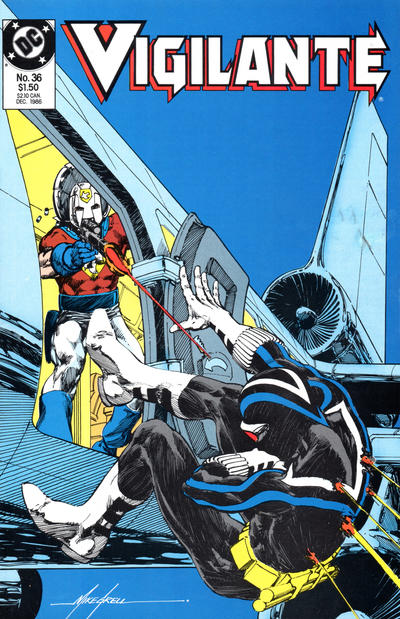
Tags: Charlton Comics, Checkmate, DC Comics, Mike Grell, miniseries, ongoing series, Pablo Marcos, Pat Boyette, Paul Kupperberg, Peacemaker, proposal, Rick Magyar, Tod Smith, Vigilante, Walter Simonson
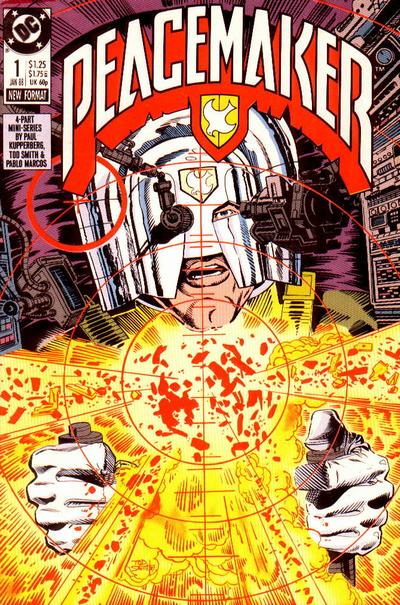
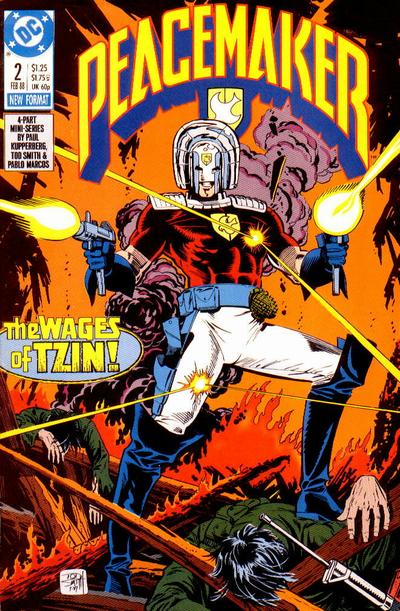
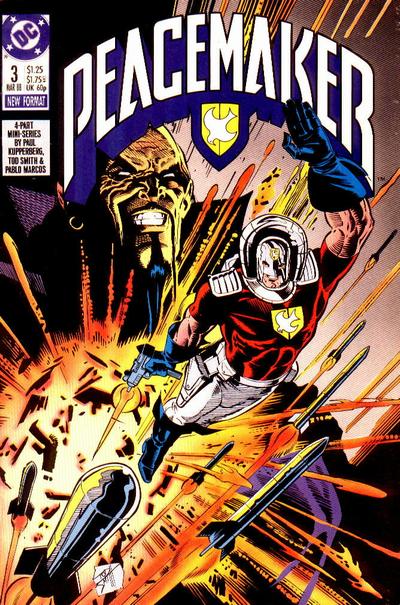
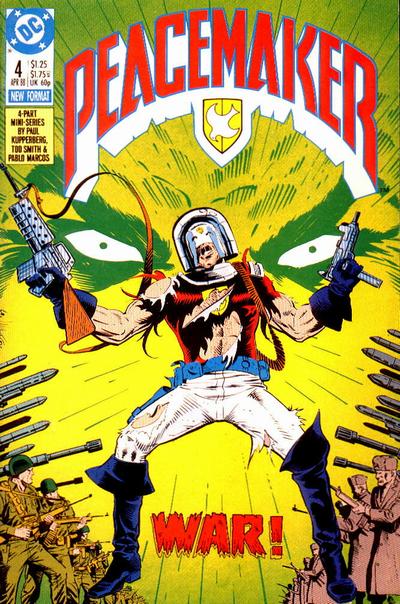
This is awesome, Paul! I would have loved to have read this book every month for years! I’ve loved your Bronze Age Superman-related stories, your Doom Patrol, Checkmate, Peacemaker mini-series, and probably many other things that I’ve forgotten, so I know the Peacemaker would have been in good hands. I think the thing I found be such a splendid surprise is I’m from Indiana (Kokomo, not Rome), I went Ball State! And I had an over-protective mother who would never get me a real bow and arrow, just ones with suction cups ( mine never stuck to anything!) Thanks for sharing!
Sincerely,
Scott E. Hileman